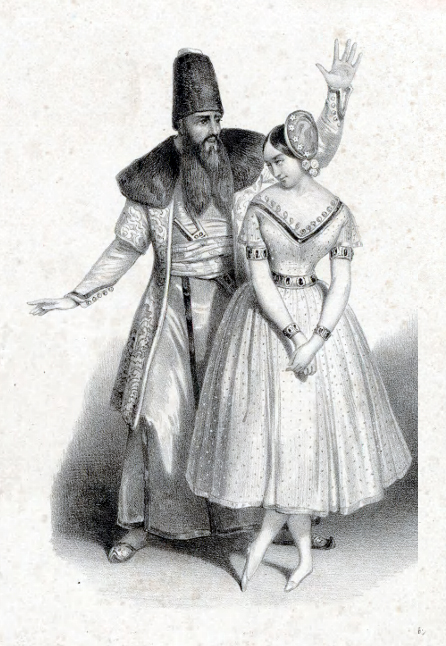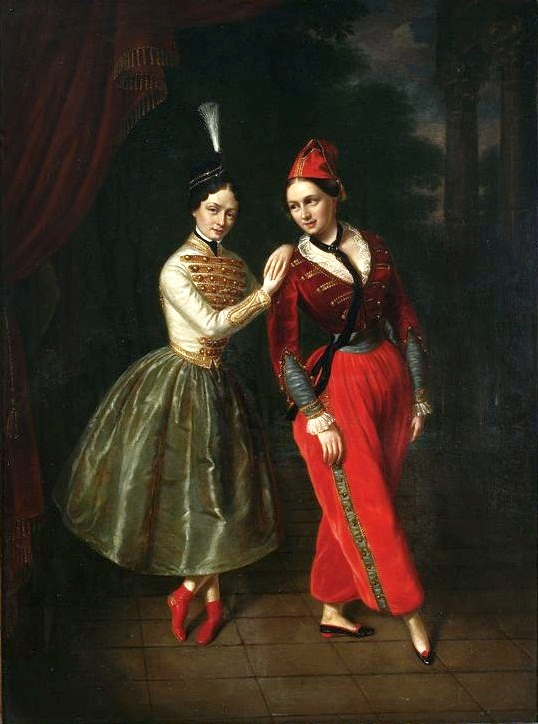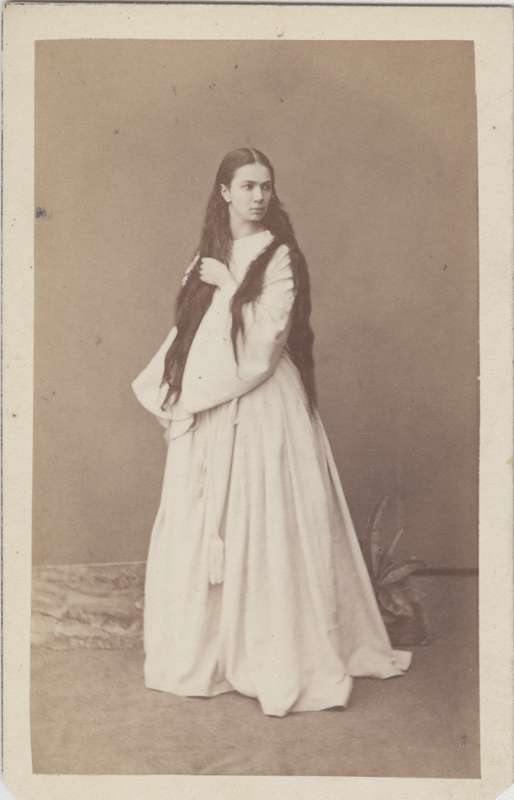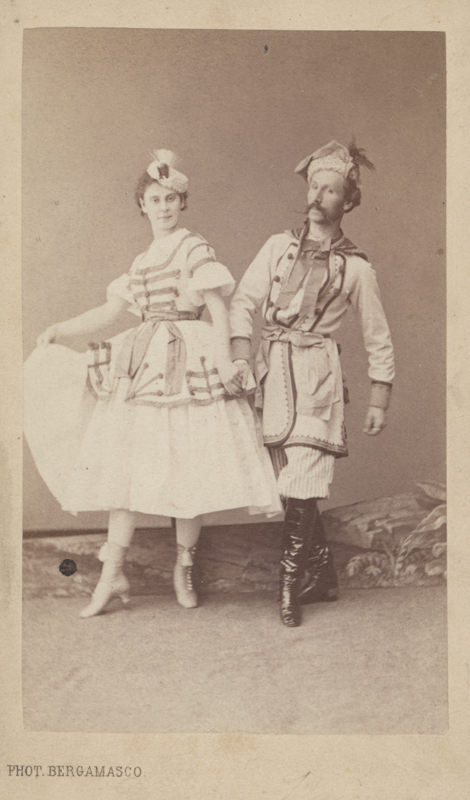Ballet pantomime in three acts and seven scenes
Music by Napoléon Henri Reber and François Benoist
Libretto by Henri Vernoy de Saint-Georges and Joseph Mazilier
Designs by Heinrich Wagner and Andrei Roller
World Première
23rd September 1840
Ballet du Théâtre de l’Académie Royale de Musique, Paris
Choreography by Joseph Mazilier
Original 1840 Cast
Uriel
Pauline Leroux
Frédéric
Joseph Mazilier
Lilia
Louise Fitz-James
Saint Petersburg Première
22nd February [O.S. 10th February] 1848
Imperial Bolshoi Kamenny Theatre
Choreography by Marius Petipa & Jean Petipa
Original 1848 Cast
Satanella
Yelena Andreyanova
Count Fabio
Marius Petipa
Hortensius
Jean Petipa
Première of Petipa’s first revival
30th October [O.S. 18th October] 1866
Imperial Bolshoi Kamenny Theatre
Original 1866 Cast
Satanella
Praskovya Lebedeva
Count Fabio
Lev Ivanov
Première of Petipa’s final revival
7th May [O.S. 25th April] 1868
Imperial Bolshoi Kamenny Theatre
Original 1868 Cast
Satanella
Alexandra Vergina
Count Fabio
Lev Ivanov
History
The original production
Le Diable amoureux was a ballet-pantomime created by Joseph Mazilier and the librettist Jules-Henri Vernoy de Saint-Georges to the music of French composers Napoléon Henri Reber and François Benoist. This ballet came at a pivotal point in the careers of both Mazilier and Saint-Georges. The year before, 1839, the two men had collaborated on Mazilier’s first ballet La Gipsy, which was inspired by Miguel de Cervantes’s Novelas ejemplares and starred Fanny Elssler as Sarah, the eponymous heroine. La Gipsy was an unanimous success and proved Mazilier’s choreographic talent as well as Saint-Georges’s understanding of the medium. The success of La Gipsy encouraged Henri Duponchel, the Director of the Opéra at the time, to commission Mazilier and Saint-Georges to collaborate on the former’s second ballet, which would be based on the 1772 occult romance novel Le Diable amoureux (The Devil in Love) by Jacques Cozette. Saint-Georges submitted the new libretto in the summer of 1839, it was accepted at the end of September and handed to Mazilier, who got to work on bringing the new work to the stage.
Duponchel had high hopes for Le Diable amoureux, envisioning a spectacular production with a cast of some of Europe’s finest dancers. However, by December, a problem arose, which forced Duponchel to postpone the ballet on short notice. The ballet was still devoid of a leading ballerina, primarily because Duponchel had hoped to engage Fanny Elssler before she embarked on her tour of America, but negotiations with Elssler on the matter failed, forcing the Director to rethink his plan. At the end of the year, it was reported that Pauline Leroux, Lucile Grahn and Nathalie Fitzjames had been chosen to head the cast in the roles of Urielle, Phoebe and Lilia, but an injury she sustained during rehearsals forced Grahn to withdraw from the production. The role of Urielle was offered to Leroux, Fitzjames was cast as Lilia and Lisa Noblet was brought into replace Grahn in the role of Phoebe; Mazilier danced the role of Frédéric. A student of Auguste Vestris and Jean-François Coulon, Pauline Leroux joined the Opéra in 1826 and from 1840, she succeeded Marie Taglioni and Elssler as Prima Ballerina after they each departed the French capital. She also regularly performed in London, becoming a public favourite of the English balletomanes. Between 1837 and 1839, however, she had had her fair share of misfortunes after an untimely attack of rheumatism, which forced her to step down from doubling Taglioni’s roles. In 1837, she tore a ligament in her right leg during a rehearsal for La Fille du Danube and for many months, she could barely stir from her sofa. The best doctors in Paris feared that she would never be able to dance again, but thanks to some encouragement from the old Vestris, who gave her all the hope and courage she needed, Leroux’s willpower found its strength and she began to recover. By 1838, she had not appeared on stage for more than two years. Leroux probably saw her casting as Urielle as a compensation after all she had been through, but her journey to the première of Le Diable amoureux was not a smooth road. One day, during rehearsals, her foot got caught in a trap, but she narrowly avoided a serious accident and then, she fell ill just before the première, but the performance was only postponed by two days.

Libretto
The first act takes place in the park surrounding the villa of Phoebe, who is being courted by the nobleman Frédéric, but Frédéric’s roving eye catches Lilia, a peasant girl who is engaged to entertain the guests with dances. But Lilia is more than just a peasant girl as she reminds Frédéric that her mother was his nurse and they played together as children. Phoebe interrupts the exchange and tells Frédéric to send the peasant girl packing with a gift of money, but instead, he gives Lilia a ring, which make Phoebe jealous. To show her displeasure, Phoebe delights in the compliments being paid to her by the other male guests and Frédéric retaliates by trying his luck at the gaming table, but ends up losing his fortune. The kind-hearted Lilia returns his ring and gives him a gold cross. However, Frédéric is convinced he was cheated by one of the gamblers and swords are drawn, but a duel is averted by Phoebe’s intervention. The scenario changes to the second scene, which takes place in the library at Frédéric’s castle. Over the fireplace is a painting depicting an ancient family legend of an ancestor who sold his soul to Beelzebub and was given a demon as a page. Frédéric enters with his tutor. Distraught at facing ruin and desperate, he can only think of one solution to his problems – to seek the aid of Beelzebub as his ancestor did. In a book of black magic, he finds the required incantation, which he recites, and Beelzebub duly appears, accompanied by a demoness, Urielle. Transformed into a page, Urielle is commanded to do Frédéric’s bidding. After Beelzebub vanishes, Frédéric falls asleep after a splendid supper and Urielle appears in his dreams as an alluring dancer who vanishes once he awakens. A crowd of creditors arrive at the castle, demanding payment, but Urielle strikes them motionless and bags of gold mysteriously appear. However, when the creditors open them, they are found to contain only puffs of smoke, but Urielle has retained receipts from them and they are left to bemoan their losses.
The second act opens on a wild orgy taking place at Frédéric’s palace; Frédéric is now rich and has seemingly become ensnared by a sinful life. Urielle, still dressed as a page, invites Phoebe to join her in a dance entitled the pas de diable, a pas d’action in which Urielle proceeds to bewitch Phoebe into forgetting Frédéric. Phoebe is fascinated by the page and although she attempts to come to her sense, she becomes so enraptures that she completely loses herself in a delirious frenzy under Urielle’s spell. Seeing this, Frédéric dismisses the page and, growing ardent towards Phoebe, is distracted when an apparition of Lilia suddenly and momentarily appears, which reminds him of his love for his childhood playmate. Lilia then arrives with her mother and Phoebe, overcome with jealousy, draws a knife and proceeds to stab Frédéric, but Lilia intervenes and averts the blow. In the confusion, Frédéric is arrested, but Urielle spirits him away through the wall. The scene shifts to a fisherman’s hut by the sea and in the background is a chapel surmounted on a hill. Lilia and her mother emerge from the hut and Frédéric comes rushing in to ask Lilia to be his wife, but then Phoebe arrives and is enraged to find him with Lilia. A band of pirates arrives and Phoebe bribes them into abducting Lilia, but Urielle witnesses this and offers the chief pirate a larger bribe to carry off Phoebe instead. Frédéric, who has not witnessed the incident of the pirates, encounters Urielle and asks for her blessing of his marriage to Lilia. Urielle, who has fallen in love with Frédéric, becomes more and more agitated as the wedding procession forms. The doors of the chapel open, revealing the candlelit altar, but as the couple make their way down the aisle, a sudden flash of lightning strikes the bride. Horrified, Frédéric lifts her veil, only to discover that it is not Lilia, but Urielle. Realising that Lilia has been abducted by the pirates, Frédéric and his friends leave in pursuit. As Lilia’s mother and the other women kneel in prayer, Urielle’s body bursts into flames and disappears into the earth.
The third act opens in the grotto of Beelzebub, where Urielle is lying unconscious at his feet. Furious that she has failed in her mission to seduce Frédéric, Beelzebub commands Urielle to make sure that Frédéric signs over his soul. The scene then changes to a slave-market in Ispahan, where the pirates bring their captives to sell. From another ship, Frédéric disembarks and Lilia begs him to bid for her, but the Grand Vizier outbids him. Frédéric is furious, but Urielle offers to help him reclaim Lilia if he will sign away his soul and he is so desperate that he unthinkingly complies. Urielle transforms herself into a bayadère and performs a pas de bayadère, leaving the Grand Vizier completely spellbound by her dancing. She tells him that Frédéric is her master and when Frédéric is asked what he will take for her, he demands Lilia in exchange. The Vizier is in despair at losing Lilia, but then the pirate chief appears with Phoebe and the Vizier is happy to take her instead. The next scene takes place back at Frédéric’s castle, where he and Lilia have taken refuge. When Frédéric is alone, Urielle appears to him and orders him to follow her, but she is enraged to discover that he and Lilia are due to marry. When Lilia returns, Frédéric declares he would rather kill himself than submit to Urielle’s demands. Before he can carry out his threat, Urielle stops him; her good nature has been aroused. She tears up the contract and, begging Frédéric to place his hand on her heart, she expires. In an apotheosis, a lake of fire overlooked by a monstrous flaming rock is shown. Urielle’s body is laid at Beelzebub’s feet when, suddenly, an angel appears on the rock and restores her to life. Holding Lilia’s cross and rosary, Urielle mounts the steps towards the angel, who takes her into his arms and they ascend into Heaven.
World Première
Le Diable amoureux premièred on the 23rd September 1840 and was a great success. The ballet was hailed by such critics as Hippolyte Lucas, who described it as “one of the prettiest ballets the Opéra had ever produced”, and the composer Hector Berlioz thought it was, quoting Ivor Guest, ‘varied and quite entertaining, if not particularly original.’ Sure enough, though Saint-Georges took the idea for his libretto from Cazotte’s novel, retaining the theme of a demon falling in love with a mortal, the result was quite original.
The role of Urielle in this complex plot was a challenge for Pauline Leroux, but never once during the three-hour-long ballet was she ever fatigued. After all her troubles, Leroux was rewarded with a great triumph as her performed received unanimous acclaim. Many even observed that her prolonged absence had seemed to enhance her abilities, as she presented wonderful qualities of poise, airiness and elegance and emphasised “the most precious traditions of the noble school, of which she has always been one of the most graceful exponents.”
Le Diable amoureux made its début in London in 1841 at with Marie Guy-Stéphans as Urielle. Leroux would later reprise and perform her role of Urielle in London at the Drury Lane Theatre in the summer of 1843. The ballet was staged at the Grand Theatre in Warsaw, Poland in 1853 under the title Asmodea, diabel rozkochany (the role of Urielle was renamed to Asmodea) and starred the sisters Karolina and Anna Straus, the theatre’s Prima Ballerinas, in the roles of Lilia and Asmodea respectively (see fig. 2).

In 1844, Jean Petipa staged Le Diable amoureux at the Teatro del Circo in Madrid, with his son Marius as Count Frédéric and Marie Guy-Stéphans as Urielle. The ballet was well received in the Spanish capital, and it would later play a very significant role in the early years of Petipa’s career in Russia.
Le Diable amoureux in Russia
Within months of Petipa’s arrival in Saint Petersburg, his father followed him to the Imperial Russian capital, taking up the post of professor of male dancing at the Imperial Ballet School. After Petipa’s successful Russian début in Paquita, the next Parisian ballet he would stage for the Imperial Theatres was Le Diable amoureux, for which he collaborated with his father. The father and son duo staged the ballet under the title Satanella, in which the names of the characters were changed from Urielle to Satanella and Frédéric to Count Fabio and it premièred at the Imperial Bolshoi Kamenny Theatre on the 22nd February [O.S. 10th February] 1848, with Elena Andreyanova as Satanella and Petipa as Count Fabio. Satanella was one of the ballets that Petipa staged in Moscow when he and Andreyanova were engaged to perform at the Imperial Bolshoi Theatre later that year. Andreyanova’s Moscow performance as Satanella was hugely successful and she was showered with countless flowers and gifts from the public. Petipa revived Satanella on two occasions for the Imperial Ballet. For his first revival, new music additions were composed by Cesare Pugni. Petipa’s first revival of Satanella premièred at the Imperial Bolshoi Kamenny Theatre on the 30th October [18th October] 1866 with Praskovya Lebedeva as Satanella and Lev Ivanov as Count Fabio. Two years later, Petipa staged his second revival with more new musical additions by Pugni. His second revival premièred at the Imperial Bolshoi Kamenny Theatre on the 7th May [O.S. 25th April] 1868, with Alexandra Vergina as Satanella and Ivanov as Count Fabio.

The most famous and only piece known today that is associated with Petipa’s production of Satanella is the pas de deux entitled Le Carnaval de Venise or the Satanella Pas de deux. In 1857, Petipa created a new concert pas de deux for the benefit performance of the Italian Prima Ballerina Amalia Ferraris, for which he partnered the ballerina. He choreographed the pas de deux to new music arranged by Cesare Pugni from an air taken from Nicolò Paganini’s piece for violin known as Carnevale di Venezia (Op.10). The pas de deux was titled as Le Carnaval de Venise. When Petipa first revived Satanella in 1866, Le Carnaval de Venise was interpolated into the third act of the ballet, where it was retained for many years and it lived on long after the full-length production of Satanella left the Imperial Ballet’s repertoire. At one point, Petipa revived the pas de deux for Pierina Legnani and the choreography performed by Legnani, especially for the female variation, appears to have survived to this day, at least partially.
In Russia, this pas de deux is known as either the Fascination Pas de deux from Satanella, or The Carnival in Venice Pas de deux, or Venetian Carnival Pas de deux. In the west, it is known simply as the Satanella Pas de deux. The multiple titles of the piece derive from its origins in Satanella and from the fact that the music had its basis in Paganini’s composition for violin Carnevale di Venezia (Op. 10). Today, the Satanella pas de deux is a staple of the classical ballet repertoire and the ballet competition circuit. The pas de deux is featured prominently in the celebrated documentary The Children of Theatre Street, which is hosted by Princess Grace of Monaco and profiles students attending the Vaganova Choreographic Institute.
A revival of Petipa’s version of Satanella was staged at the Imperial Bolshoi Theatre in Moscow on the 18th February [O.S. 6th February] 1897 by Ivan Clustine, who is most noted for being the choreographer for Anna Pavlova’s company. Petipa’s version of Satanella did not survive, but Le Diable amoureux was notated by Henri Justament and is part of his collection of 19th century French ballets and could be Mazilier’s choreography.

Sources
- Ivor Guest (2008) The Romantic Ballet in Paris. Alton, Hampshire, UK: Dance Books Ltd
- Ivor Guest (1954) The Romantic Ballet in England. Binsted, Hampshire, UK: 2014 ed. Dance Books Ltd
- Nadine Meisner (2019) Marius Petipa: The Emperor’s Ballet Master. New York, USA: Oxford University Press
- Marius Petipa, Russian Ballet Master: The Memoirs of Marius Petipa. Translated ed. by Helen Whittaker, introduction and edited by Lillian Moore. London, UK: Dance Books Ltd (1958)
Photos and images: © Dansmuseet, Stockholm © Большой театр России © Victoria and Albert Museum, London © Государственный академический Мариинский театр © CNCS/Pascal François © Bibliothèque nationale de France © Musée l’Opéra © Colette Masson/Roger-Viollet © АРБ имени А. Я. Вагановой © Михаил Логвинов © Михайловский театр, фотограф Стас Левшин. Партнёры проекта: СПбГБУК «Санкт-Петербургская государственная Театральная библиотека». ФГБОУВО «Академия русского балета имени А. Я. Вагановой» СПбГБУК «Михайловский театр». Михаил Логвинов, фотограф. Martine Kahane.
